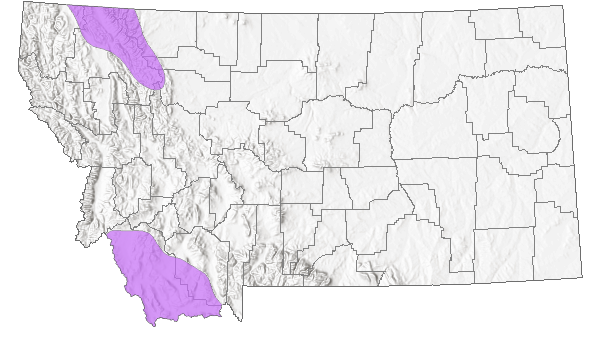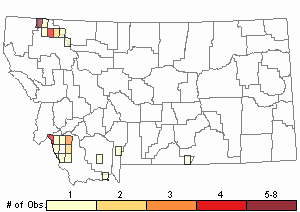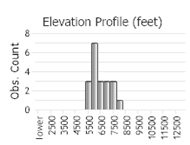View in other NatureServe Network Field Guides
NatureServe
Montana
Utah
Wyoming
Idaho
Wisconsin
British Columbia
South Carolina
Yukon
California
New York
Slim Larkspur - Delphinium depauperatum
State Rank Reason (see State Rank above)
Delphinium depauperatum has been identified in Beaverhead, Flathead, and possibly Jefferson Counties in western Montana. It is found in common habitats, yet relatively few occurrences have been documented.
- Details on Status Ranking and Review
Population Size
ScoreU - Unknown
Range Extent
ScoreF - 20,000-200,000 sq km (~8,000-80,000 sq mi)
Area of Occupancy
ScoreD - 6-25 4-km2 grid cells
Number of Populations
ScoreB - 6 - 20
Number of Occurrences or Percent Area with Good Viability / Ecological Integrity
ScoreC - Few (4-12) occurrences with excellent or good viability or ecological integrity
Environmental Specificity
ScoreC - Moderate. Generalist or community with some key requirements scarce
Long-term Trend
ScoreU - Unknown
Trends
ScoreU - Unknown
Threats
ScoreU - Unknown
CommentThreat categories include: Roads & railroads, Fire & fire suppression, Invasive non-native/alien species/diseases. However, often occurs in more protected areas and seems to tolerate ditches.
Intrinsic Vulnerability
ScoreU - Unknown
General Description
Plants: Perennial (Hitchcock et al. 1964) from a cluster of tuber-like roots; stems mostly glabrous, 15–60 cm (Lesica 2012), mostly 1(2) in number, upright, sometimes slightly hollow (fistulose), little-branched or simple; vestiture of fine hairs or somewhat glandular-puberulent almost to the base and the inflorescence almost always glandular-pubescent (Hitchcock et al. 1964).
Leaves: Leaves basal and on lower stem (Lesica 2012), few and long-petiolate; blades triparted most of their length (Hitchcock et al. 1964), 2–6 cm wide (Lesica 2012); ultimate lobes parted less deeply once (occasionally twice) forming oblong sections (Hitchcock et al. 1964) to 3 mm wide (Lesica 2012); upper stem leaves few, bract-like and linear-lobed (Hitchcock et al. 1964).
Inflorescence: A terminal raceme, often branched, 3- to 15-flowered, lower flowers as long to longer than pedicels (Lesica 2012).
(Lesica's contribution adapted from
Lesica et al. 2012. Manual of Montana Vascular Plants. BRIT Press. Fort Worth, TX)
Phenology
Flowers from late May through early July (Hitchcock et al. 1964).
Diagnostic Characteristics
Delphinium depauperatum, Slim Larkspur, is frequently confused with
D. nuttallianum, Nuttall’s Larkspur. Slim Larkspur, however, has cylindric inflorescences, lower flowers the same length or longer than their stalks (Lesica 2012), upright fruits, and winged seeds (FNA 1997). This contrasts with the pyramidal inflorescences, lower flowers shorter than their stalks (Lesica 2012), spreading fruits, and ringed seeds of Nuttall’s Larkspur (FNA 1997).
(Lesica's contribution adapted from
Lesica et al. 2012. Manual of Montana Vascular Plants. BRIT Press. Fort Worth, TX)
Species Range
Montana Range
Range Descriptions

 Native
Native
Range Comments
WA to w MT, south to ne CA and c NV (Hitchcock et al. 1964). Known in Montana from Beaverhead and Flathead Counties (Lesica 2012).
(Lesica's contribution from Lesica et al. 2012. Manual of Montana Vascular Plants. BRIT Press. Fort Worth, TX)
Observations in Montana Natural Heritage Program Database
Number of Observations: 37
(Click on the following maps and charts to see full sized version)
Map Help and Descriptions
Relative Density

Recency



 (Observations spanning multiple months or years are excluded from time charts)
(Observations spanning multiple months or years are excluded from time charts)
Habitat
Moist sagebrush basins to subalpine meadows (Hitchcock et al. 1964); moist meadows, often along streams; montane (Lesica 2012).
(Lesica's contribution from
Lesica et al. 2012. Manual of Montana Vascular Plants. BRIT Press. Fort Worth, TX)
Ecology
Despite growing in moist habitats, especially in meadows that dry in the summer, Slim Larkspur has roots less like those of tall hollow-stemmed species and more like those of low-growing
Delphiniums that grow in dry conditions (Hitchcock et al. 1964).
Frequently growing in the same meadows, Slim Larkspur inhabits damper sites, often near streams, and flowers later than the similar-appearing Nuttall's Larkspur (
D. nuttallianum). The two species do produce hybrids, but rarely (FNA 1997).
POLLINATORS The following animal species have been reported as pollinators of this plant species or its genus where their geographic ranges overlap:
Bombus vagans,
Bombus appositus,
Bombus auricomus,
Bombus borealis,
Bombus centralis,
Bombus fervidus,
Bombus flavifrons,
Bombus mixtus,
Bombus occidentalis,
Bombus pensylvanicus,
Bombus griseocollis,
Bombus impatiens, and
Bombus kirbiellus (Plath 1934, Macior 1974, Bauer 1983, Thorp et al. 1983, Wilson et al. 2010, Colla and Dumesh 2010, Koch et al. 2012, Pyke et al. 2012, Miller-Struttmann and Galen 2014, Williams et al. 2014).
Reproductive Characteristics
Flowers: Bilaterally symmetric; sepals spreading, dark blue, sparsely hairy, 8–12 mm (Lesica 2012), usually glandular; upper sepal forming a spur (11)13-15(17) mm in length (Hitchcock et al. 1964); petals blue to white, the lower blades cleft halfway to the base (Lesica 2012).
Fruits: Follicles most often glandular and puberulent, seldom smooth (Hitchcock et al. 1964), 11–17 mm (Lesica 2012); seeds 1.5-2 mm in length, with wing-angles whitish (Hitchcock et al. 1964).
(Lesica's contribution adapted from
Lesica et al. 2012. Manual of Montana Vascular Plants. BRIT Press. Fort Worth, TX)
Stewardship Responsibility
Threats or Limiting Factors
STATE THREAT SCORE REASON
Reported threats to Montana's populations of Slim Larkspur indicate one population located at a campground where trampling by recreationists is likely (MTNHP Threat Assessment 2021).
References
- Literature Cited AboveLegend:
 View Online Publication
View Online Publication Bauer, P.J. 1983. Bumblebee pollination relationships on the Beartooth Plateau tundra of Southern Montana. American Journal of Botany. 70(1): 134-144.
Bauer, P.J. 1983. Bumblebee pollination relationships on the Beartooth Plateau tundra of Southern Montana. American Journal of Botany. 70(1): 134-144. Colla, S.R. and S. Dumesh. 2010. The bumble bees of southern Ontario: notes on natural history and distribution. Journal of the Entomological Society of Ontario 141:39-68.
Colla, S.R. and S. Dumesh. 2010. The bumble bees of southern Ontario: notes on natural history and distribution. Journal of the Entomological Society of Ontario 141:39-68. Flora of North America Editorial Committee. 1997. Flora of North America North of Mexico. Volume 3. Magnoliophyta: Magnoliidae and Hamamelidae. Oxford University Press, Inc., New York, NY. xxiii + 590 pp.
Flora of North America Editorial Committee. 1997. Flora of North America North of Mexico. Volume 3. Magnoliophyta: Magnoliidae and Hamamelidae. Oxford University Press, Inc., New York, NY. xxiii + 590 pp. Hitchcock, C. L., A. Cronquist, M. Ownbey, and J. W. Thompson. 1964. Vascular Plants of the Pacific Northwest. Part 2: Salicaceae to Saxifragaceae. University of Washington Press, Seattle. 597 pp.
Hitchcock, C. L., A. Cronquist, M. Ownbey, and J. W. Thompson. 1964. Vascular Plants of the Pacific Northwest. Part 2: Salicaceae to Saxifragaceae. University of Washington Press, Seattle. 597 pp. Koch, J., J. Strange, and P. Williams. 2012. Bumble bees of the western United States. Washington, DC: USDA Forest Service, Pollinator Partnership. 143 p.
Koch, J., J. Strange, and P. Williams. 2012. Bumble bees of the western United States. Washington, DC: USDA Forest Service, Pollinator Partnership. 143 p. Lesica, P., M.T. Lavin, and P.F. Stickney. 2012. Manual of Montana Vascular Plants. Fort Worth, TX: BRIT Press. viii + 771 p.
Lesica, P., M.T. Lavin, and P.F. Stickney. 2012. Manual of Montana Vascular Plants. Fort Worth, TX: BRIT Press. viii + 771 p. Macior, L.M. 1974. Pollination ecology of the Front Range of the Colorado Rocky Mountains. Melanderia 15: 1-59.
Macior, L.M. 1974. Pollination ecology of the Front Range of the Colorado Rocky Mountains. Melanderia 15: 1-59. Miller-Struttmann, N.E. and C. Galen. 2014. High-altitude multi-taskers: bumble bee food plant use broadens along an altitudinal productivity gradient. Oecologia 176:1033-1045.
Miller-Struttmann, N.E. and C. Galen. 2014. High-altitude multi-taskers: bumble bee food plant use broadens along an altitudinal productivity gradient. Oecologia 176:1033-1045. MTNHP Threat Assessment. 2021. State Threat Score Assignment and Assessment of Reported Threats from 2006 to 2021 for State-listed Vascular Plants. Botany Program, Montana Natural Heritage Program, Helena, Montana.
MTNHP Threat Assessment. 2021. State Threat Score Assignment and Assessment of Reported Threats from 2006 to 2021 for State-listed Vascular Plants. Botany Program, Montana Natural Heritage Program, Helena, Montana. Plath, O.E. 1934. Bumblebees and their ways. New York, NY: Macmillan Company. 201 p.
Plath, O.E. 1934. Bumblebees and their ways. New York, NY: Macmillan Company. 201 p. Pyke, G.H., D.W. Inouye, and J.D. Thomson. 2012. Local geographic distributions of bumble bees near Crested Butte, Colorado: competition and community structure revisited. Environmental Entomology 41(6): 1332-1349.
Pyke, G.H., D.W. Inouye, and J.D. Thomson. 2012. Local geographic distributions of bumble bees near Crested Butte, Colorado: competition and community structure revisited. Environmental Entomology 41(6): 1332-1349. Thorp, R.W., D.S. Horning, and L.L. Dunning. 1983. Bumble bees and cuckoo bumble bees of California (Hymenoptera: Apidae). Bulletin of the California Insect Survey 23:1-79.
Thorp, R.W., D.S. Horning, and L.L. Dunning. 1983. Bumble bees and cuckoo bumble bees of California (Hymenoptera: Apidae). Bulletin of the California Insect Survey 23:1-79. Williams, P., R. Thorp, L. Richardson, and S. Colla. 2014. Bumble Bees of North America. Princeton, NJ: Princeton University Press. 208 p.
Williams, P., R. Thorp, L. Richardson, and S. Colla. 2014. Bumble Bees of North America. Princeton, NJ: Princeton University Press. 208 p. Wilson, J.S., L.E. Wilson, L.D. Loftis, and T. Griswold. 2010. The montane bee fauna of north central Washington, USA, with floral associations. Western North American Naturalist 70(2): 198-207.
Wilson, J.S., L.E. Wilson, L.D. Loftis, and T. Griswold. 2010. The montane bee fauna of north central Washington, USA, with floral associations. Western North American Naturalist 70(2): 198-207.
- Additional ReferencesLegend:
 View Online Publication
View Online Publication
Do you know of a citation we're missing? King, C. R. 1953. The Ranunculaceae of Montana. M.S. Thesis, Bozeman, MT: Montana State College. 82 p.
King, C. R. 1953. The Ranunculaceae of Montana. M.S. Thesis, Bozeman, MT: Montana State College. 82 p. Lesica, P., M.T. Lavin, and P.F. Stickney. 2022. Manual of Montana Vascular Plants, Second Edition. Fort Worth, TX: BRIT Press. viii + 779 p.
Lesica, P., M.T. Lavin, and P.F. Stickney. 2022. Manual of Montana Vascular Plants, Second Edition. Fort Worth, TX: BRIT Press. viii + 779 p. Sawyer, P.T. 1967. Biosystematic studies of species of delphinium occurring in Montana. M.Sc. Thesis. Bozeman, MT: Montana State University. 56 p.
Sawyer, P.T. 1967. Biosystematic studies of species of delphinium occurring in Montana. M.Sc. Thesis. Bozeman, MT: Montana State University. 56 p. Sawyer, P.T. 1970. Systematic studies of non-fistulose delphinium taxa common to Montana. Ph.D. Dissertation. Bozeman, MT: Montana State University. 84 p.
Sawyer, P.T. 1970. Systematic studies of non-fistulose delphinium taxa common to Montana. Ph.D. Dissertation. Bozeman, MT: Montana State University. 84 p.
- Web Search Engines for Articles on "Slim Larkspur"





